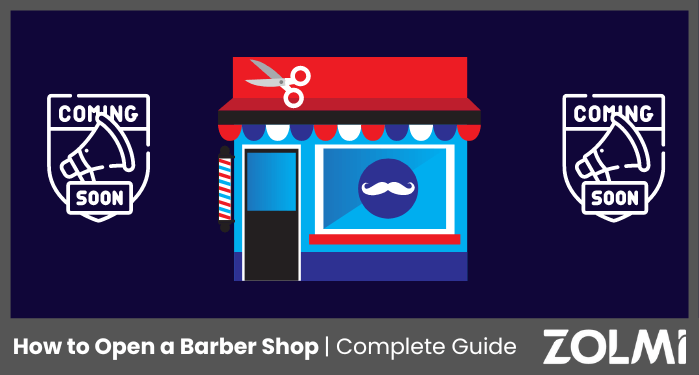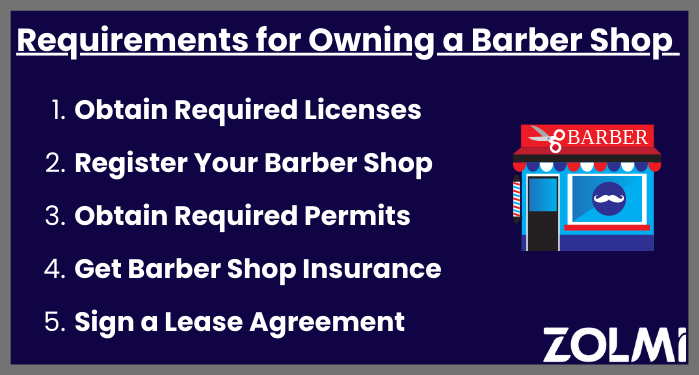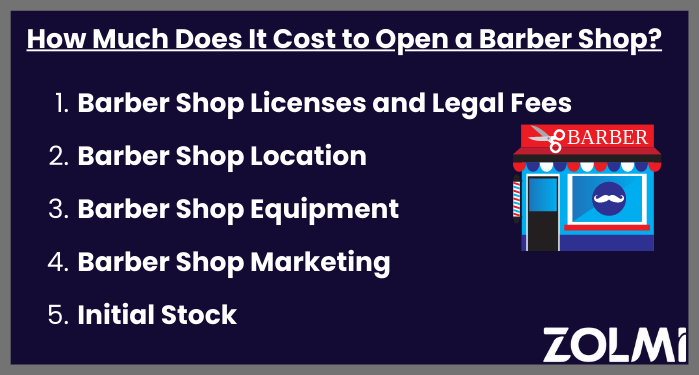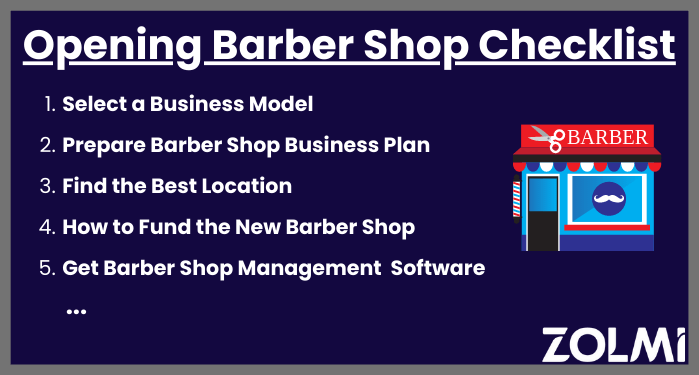How to Open a Barber Shop | Checklist for 2024


No matter if you are an established barber or a beginning one, you would need guidance on how to open a barber shop. Our guide will allow you to apply a structured approach to budget planning, legal requirements compliance, hiring staff, marketing plan and more for your new business.
We will talk about legal requirements as well business planning, budgeting, and marketing activities and some checklists to help you start a new barber shop.
Can you start a barbershop without a license?
Business licenses and permits can differ between states and provinces and, in some cases, even between towns.
Here's a summary of the common business license steps and permit requirements to assist you to get going:

You can get it from the IRS or your state's website, and you'll need to provide your business license, personal details, and a general description of your services and products.
The price of insurance coverage typically differs between about $50 to $250 a month, and it takes care of you, your personnel, and your customers. The most common kind is called "general liability" insurance and protects against damage to your property, claims made against you, or in some cases, even harm to your business's reputation.
A lawyer can assist you in drawing this up, although templates are obtainable online. You'll wish to ensure to have this signed prior to investing any money in the existing barber shop or making any modifications to the venue. If you're purchasing the place, ensure to seek advice from a legal adviser to close the sale.
We recommend you to check out our post on Barber Shop Logo.
How much does barber shop equipment cost?
You have the choice of leasing equipment or buying it outright. Both have their benefits and downsides.
A brand-new complete set of barber shop equipment and tools will cost you around $27,000, whereas with leasing you just make monthly payments. These rates will depend on the company, and many do offer you the possibility to buy the equipment or lease new items later on.
Many companies will provide you the possibility to lease larger, more costly items such as styling chairs and backwash station chairs, but be prepared to shop around for smaller items such as carts, trolleys, and service accessories.
When you begin equipping up, bear in mind that your requirements might change in the future, so you'll want to prepare not only what you purchase now but what you may require later on.
Your barber shop website is one of your barber shop's most crucial marketing tools, especially if your target audience is younger or professional. They tend to value the convenience of online booking and use social media to look for the services they're searching for.
You can create your barber shop website using a completely free design template online or employ a specialist to help. They generally charge between $300- $700 for this service. Or, you can invest in good barber shop management software that includes a website building function.
Don't forget about business cards and leaflets, too. Make sure to reach out to the local community with the help of printed products that you can distribute at your barber shop and local businesses.
You may even want to invest in an ad on the radio or in the local newspapers.

Your total stock will vary depending upon the size and staffing needs of your barbershop. When you work out product needs, make sure to include disposable items utilized in each service, in addition to retail items and professional materials.
Do not miss our post Barber Shop Price List.
Some people are curious about how to start a hair barbershop. Similar to any new business venture, a bit of planning goes a long way. Here are the guidelines that you can follow to help turn your dream into a prosperous business.
Will you sign up with a franchise (this comes along with a lot of assistance, however less independence), or will you run your own business? Also, you'll require to choose whether to pay your staff on commission or rent out booths/ space to independent barbers.
Is owning a barber shop profitable? The first answer sits in your business plan.
It really helps barber shop owners like yourself to remain on budget and will give you a roadmap to navigate your business. Include a marketing plan, your target market, budget, and the kinds of products/ services you'll offer clients. Add to this a breakdown of your basic recurring costs like staff salaries, insurance, back bar expenses, and marketing.
That will depend a lot on your brand and target market. Will your client base be young and professional? Then search for something near a local downtown or business center. Other barber shops might succeed in cozy areas or little towns if this fits their customers and brand.
Wondering how to open a barber shop with no money?
Insufficient funds at startup are one leading reason that barber shops can struggle. Try to have at least six months buffer. Sources of financing can include your own savings, help from family and friends, your local credit union, and loans and grants for industry startups. Make sure that you have a budget and plan to pay it back, too.
Your brand lets define your business and customers. It includes everything from your logo and name to your website and interior decoration. Pinterest is a good source of ideas to start. Select some images and words that identify your brand and use them for inspiration.

Set up your website and social network pages, pick a logo design and connect to the community. Your family and friends can be vital when it comes to forming these connections with new customers.
Ensure that you also set up your Google My Business account information with images so that customers can find you on opening day and leave feedback later.
Read more on how to build clientele as a barber fast.
Barber shop software will help you optimize your barber shop calendar, allow easy online booking, handle your staff schedule, take payments, track and order inventory, and more, saving you hours of hassle and cash every week.
We recommend you to check out our post How To Manage a Barber Shop.
Various companies offer various equipment and rates, including simple app-based systems or more complex appliances with receipt printing. Do not be afraid to look around.
Advertise any openings and pick your dream team, then plan your training. Read more on barber job description to know what best credentials to look for.
That depends greatly on your branding and clients, so select an assortment that compliments your services and vision.
We've prepared an opening barber shop checklist pdf to assist you to begin.
That includes everything from furniture to the tools and tech that your staff will need. Start by making a list of the small and big things that your space should have, separating "needs" from "wants" to remain on budget.
Remember, the equipment can normally be leased or purchased. However, tools and furniture will probably have to be bought.
Your barber shop shopping list must include:
We've prepared an opening a barber shop equipment list pdf to assist you to begin.
Do not miss our post on barber shop franchise.
Are barber shops profitable? They undoubtedly can be, however operating a prosperous firm takes a lot of work and devotion, too.
While there are a great deal of advantages to owning your own barbershop business, there are also some drawbacks that you'll require to be prepared for.
The best parts of barbershop ownership:
Some probable challenges to be prepared for:
We recommend you to check out our post on Barber Shop Ideas.
We hope this guide has given you some clarity on how to open a barber shop.
The most crucial thing that you can do is invest your effort and time in keeping organized right from the start. Tools like barber shop software can assist with the efficient management of your new business.
The proper planning, a clear barber shop budget plan, and a solid marketing strategy can make all the difference.
Why companies should have open business models
http://secure.com.sg/courses/ICI/Grab/Reading
Business model innovation: it's not just about technology anymore
https://www.emerald.com/insight/content/doi/10.1
Business model innovation: opportunities and barriers
https://www.sciencedirect.com/science/article/pii/S